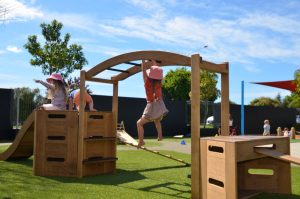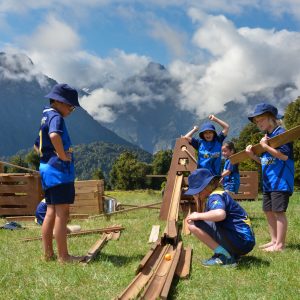In early childhood education, “play” is often associated with blocks, puzzles, or quiet imaginative corners. But one of the most profoundly formative forms of play is Big Body Play — vigorous, movement-based, full-bodied activity that engages children’s gross motor systems, energizes their bodies, and enriches their social, emotional, cognitive, and sensory development.
Big Body Play is more than “just running around.” It’s an intentional, research-backed approach to helping children learn through movement. When integrated thoughtfully into early learning environments, Big Body Play supports deeper growth across all domains of development — exactly in alignment with the vision behind Outdorable’s designs.
Below, we explore what Big Body Play is, why it matters, and how Outdorable is uniquely positioned to support and elevate it in early education settings.
Big Body Play includes any activity that invites children to engage large muscle groups in energetic movement: running, jumping, climbing, chasing, rolling, tumbling, spinning, pushing, carrying, and more. It tends to be boisterous, vigorous, and sometimes messy or unpredictable — yet deeply meaningful.
In the pedagogy guiding Big Body Play, this kind of movement is understood not as “just fun,” but as essential to children’s holistic development (physical, social, emotional, cognitive).

In short: Big Body Play is not optional. It’s essential.
Outdorable’s commitment to holistic child development aligns naturally with Big Body Play. We’ve embedded the principles of movement-rich, open-ended, nature-connected play into our product philosophy, ensuring that our designs support and elevate vigorous, exploratory movement in early learning environments.
Here’s how:
Our play systems are not rigid. They allow movement in many directions — children can climb, jump, crawl, balance, navigate — not in only one prescribed route. This openness encourages creative physical strategies and exploration, rather than limiting movement to paths or slides.
We integrate climbing walls, balance beams, stepping stones, logs, slopes, tunnels, ropes, raised platforms, wiggle bridges, and loose-parts zones. These features create multiple movement possibilities side by side — so children choose their challenge.
Children benefit from moving across different heights and textures (grass, wood, soft surfacing, mulch). Our designs often include gentle slopes, low hills, stepping logs, mounded earth forms, natural features, and transitions that encourage changes in level and movement adaptation.
We build zones where children can move elements — logs, planks, crates, tires, ropes — rearrange them, carry them, build and then move through what they build. This kind of play supports Big Body strategies combined with cognitive and construction play.

Outdorable doesn’t just deliver equipment; our design philosophy encourages educators to embed Big Body Play intentionally in daily routines. We support planning for movement breaks, structured/unstructured time, observation and scaffolding, and play reflection cycles.
When movement becomes a core pillar of early learning, the outcomes are profound. Big Body Play complements and reinforces the “Whole Child” philosophy that Outdorable already champions — each child’s physical, emotional, social, cognitive, and sensory dimensions get space to thrive.
By designing products with Big Body Play in mind, Outdorable helps early learning centres and schools move from static, passive play environments to vibrant, movement-rich landscapes that speak to children’s deepest developmental needs.
To truly bring Big Body Play to life — beyond just having the right equipment — consider these strategies:
Big Body Play is gaining traction globally in early education discourse. Advocates are speaking at major conferences, sharing research, demonstrating that movement-rich, child-led physical play is not a fringe idea — it’s an essential shift. (One such advocate Trevor Newton, will be a keynote speaker at the upcoming NAEYC conference in Orlando later in 2025.)
As early learning environments evolve to be more inclusive, child-centered, and responsive to brain and body development, Outdorable is well placed to lead — providing play landscapes that breathe, move, adapt — not just static structures.
Our mission is not to add play equipment — it’s to transform how environments support life and growth. By centering Big Body Play in our design philosophy, we ensure that every child can move, grow, mess, fail, succeed, collaborate, learn, and thrive — in body and mind.